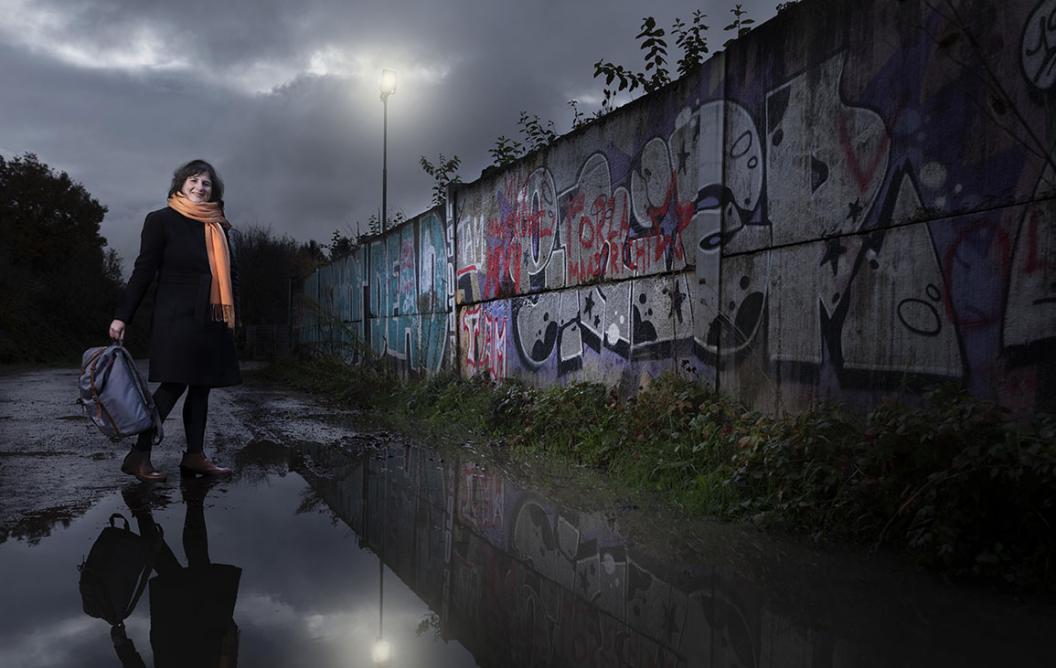Designing solidarity
EU immigration and asylum law are plagued by disharmony and dysfunction. Lilian Tsourdi, assistant professor of International and European Law, is investigating how to improve the situation. How have we reached the status quo? What would be a better approach? And what role could solidarity play?
“I almost dropped out of law school,” she recalls, “until I took a module on human rights. It spoke to my innate sense of justice. It made me wonder what the most pressing human rights issue in Greece, my home country, was—clearly migration and asylum!” Before her PhD, Lilian Tsourdi worked as a legal trainee for the Greek Council for Refugees in Athens and as an adviser to policy NGOs in Brussels. She continues to advise European institutions and nonprofits, and, with the UN Refugee Agency, co-chairs the European Academic Refugee Interdisciplinary Network. EARIN is a regional network seeking to implement the UN Global Compact on Refugees through research, teaching and solidarity with displaced scholars and students. “These experiences have informed my research questions and methods,” she says. “They gave me a rich understanding of the different perspectives: policymakers’ processes and limitations, but also the struggles, despair and ingenuity of refugees.”
For Tsourdi, it’s important to translate her findings into practical policy recommendations. The media’s focus on immigration intensified with the large-scale arrival of people fleeing the Syrian armed conflict in 2015. “But even before that, there had been issues with how the EU regulated its common asylum system. The number of arrivals isn’t the problem. It’s a crisis of values and governance, meaning the legal design and implementation of the system for processing asylum seekers on an EU level.”
No real system
Until 1999, each EU member state had its own asylum system. Some in fact had none. As a result, EU-wide harmonisation started from an uneven field in terms of economic and institutional capacity. Between 1999 and 2013, legislation and standards around the reception and processing of asylum seekers were harmonised, but without pooling resources to finance the implementation. “It was up to each member state to either revamp their system or create one from scratch, using their national budget.” There was—and still is—no mechanism for distributing responsibility according to capacity.
Instead responsibility is assigned through the ‘Dublin system’, whereby the member state of first irregular entry processes the application. “Most arrivals are ‘irregular’,” Tsourdi points out. “All refugee-producing countries are subject to strict visa obligations, making it almost impossible to legally arrive by plane. That leaves only routes across the Mediterranean or through the Eastern border.”
Political deadlock
“On the political level, it can be difficult to disentangle unwillingness from an inability to implement obligations. During the Syrian crisis, about 1.5 million people arrived via Greece. A country of 10 million struggling with considerable economic hardship would have had to receive and process all these people. That makes no sense. Objective indicators, like size of the country and institutional and financial capacities, should be taken into account.”
Even after Syria, she says, no structural redesign was forthcoming. “In 2016 the European Commission proposed legal instruments to reform the system, but there was no agreement on how to distribute responsibility, allow free movement for recognised beneficiaries of international protection, or share financial and institutional resources.” Countries deemed undesirable or difficult to reach for refugees had an entrenched interest in maintaining the status quo.
“After four years of deadlocked negotiations between the European Parliament and the Council, in 2020 the Commission presented new proposals under the banner of a new pact on migration and asylum. Those proposals are still under negotiation.” Instead, efforts intensified to externalise protection obligations to third countries. “That’s EU jargon for co-opting non-EU countries into stopping migrants from arriving at EU borders in exchange for financial incentives and increased mobility for their own nationals. This strategy runs the risk of delegitimising the obligation to protect refugees.”
Thanks to sheer urgency and the pressure of public opinion, the Ukrainian crisis was handled more pragmatically. The Temporary Protection Directive was invoked. Registration was swift and protection seekers were distributed organically. “People could choose their own destinations, usually based on existing family ties or networks. It shows that a different way is possible and that creating obstacles is, to an extent, a policy choice.”
"The number of arrivals isn’t the problem. It’s a crisis of values and governance, meaning the legal design and implementation of the system for processing asylum seekers on an EU level."
Broader rethink
Using legal analysis and semi-structured interviews with representatives of civil society, policymakers and government officials in Greece, the Netherlands and the EU, Tsourdi aims to shed light on the influence of EU funding on implementation. “In Greece, it has created a certain leverage when it comes to respecting EU standards, but there are limits to operationalising solidarity through funding. Even significant structural funding wouldn’t make it acceptable for one member state to bear the entire operational burden.”
With colleagues from Odysseus, a network of EU academics, Tsourdi recently presented a report on legal migration to the European Parliament. The report also focused on policy design and the effectiveness of ‘talent partnerships.’ “We look at existing policies, but also point out the importance of a broader collaboration framework between the EU and third countries. This includes co-development, foreign relations and trade possibilities, increased labour movement, training and so forth.”
“There are many problems with funding and implementation,” she concludes, “but more than anything, we need a better designed legal and policy framework. Globally and within the EU, we need to rethink solidarity.”
Florian Raith (text), Arjen Schmitz (photography)
